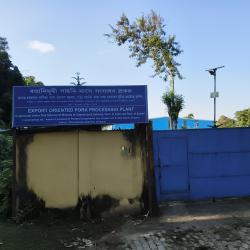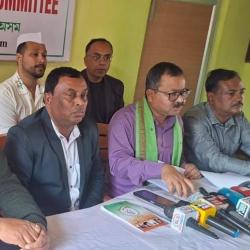Their Royal Highnesses William and Catherine, Duke and Duchess of Cambridge, this afternoon visited IFAW-WTI’s Centre for Wildlife Rehabilitation and Conservation (CWRC) near Kaziranga National Park, Assam.
CWRC, run by the International Fund for Animal Welfare (IFAW) and the Wildlife Trust of India (WTI) with support from the Assam Forest Department, is the only facility in India where orphaned and/or injured wild animals of several species are hand-raised and/or treated and subsequently returned to the wild. As of March 2016 the Centre had handled 4,322 animal cases, with 2,465 being released back to the wild – a rehabilitation rate of nearly 60 percent.
Their Royal Highnesses arrived at the Centre at half past noon and were accompanied around the grounds by WTI Executive Director Vivek Menon and IFAW President & CEO Azzedine Downes, as well as the lead veterinarian Panjit Basumatary and the centre-in-charge Rathin Barman.
They interacted with the animal keepers and even hand fed some of the orphaned animals being reared at CWRC – elephant calves Buree and Murphuli, just a few months old when they were rescued last October, now being raised on milk formula under the watchful eyes of their keepers; and Dunga, a male rhino, the youngest and newest resident at CWRC and the best of friends with the two female elephant calves.
The royal highnesses were relaxed from their early morning safari in the park and seemed at ease, feeding the orphaned animals at CWRC. The Duchess was most interested in knowing more about the youngest rhino calf at the Centre. A specially created photo album with information on each animal they saw was given to the royal couple .
“We are delighted that Their Royal Highnesses made time to visit the IFAW- WTI centre and meet staff and the animals under care,” said Azzedine Downes, President & CEO, IFAW. “With elephants and rhinos in particular facing an uncertain future due to habitat loss, human conflict and poaching, IFAW is pleased that the Duke and Duchess are able to raise public awareness of these threats to an international audience.”
“India’s biodiversity is a global treasure, and every rescued animal that we successfully rehabilitate and release helps rebuild endangered wild populations,” said Vivek Menon, Executive Director & CEO, WTI. “We are proud to share all that the CWRC staff have accomplished with the Duke and Duchess, and grateful that the Royal couple is using their influence to share it with the world.”
Urgent Corridors and the Birth of Aana
Their Royal Highnesses were then escorted to the site of the upcoming Kaziranga Discovery Park, a clinic for (and learning centre on) Asian elephants being developed by the UK-based NGO Elephant Family in collaboration with WTI.
Elephant Family has also partnered with IFAW, WTI, World Land Trust and IUCN Netherlands to form the Asian Elephant Alliance, a partnership of conservation organisations launched last year to arrest the crisis facing the world’s remaining Asian elephants, of which 60 percent (an estimated 30,000) are in India.
While India has long celebrated and revered its elephants, its rapid economic development has meant that traditional elephant lands are now being used by people for agriculture, roads, railway lines, mines, dams and the like. Conflict between humans and displaced elephants presently costs the country over 400 human and 100 elephant lives every year, and millions of rupees in crop and property damage.
As the Royal couple sat on cane murahs (chairs) under a thatched sit-out, WTI CEO Vivek Menon briefed them about the importance of elephant corridors, which allow elephants safe passage between and adjacent to protected habitats without intrusion into human-use areas. The Asian Elephant Alliance has prioritised the securement of 100 such corridors identified in India, and aims to raise £20m for this cause.
It is estimated that 500,000 Indian families are affected by Human Elephant Conflict annually and people who live in elephant corridors fear for their lives and livelihoods. Ruth Powys, CEO of Elephant family introduced Their Royal Highnesses to villagers from Ram Terang, located in the autonomous tribal Karbi Anglong hills in Assam, which earlier lay right in the middle of an ancient elephant route. Elephant Family, WTI and the Karbi Anglong Autonomous Council came together to build New Ram Terang, a better equipped and safer village 6 km uphill from the corridor. The villagers shifted into their new homes in November 2015, and their representatives here, including children, spoke with the Royal couple about their experiences before and after the relocation.
Finally, Their Royal Highnesses were taken to be introduced to renowned Indian artist Bulbul Sharma, 15 schoolchildren (and their headmistress) from the nearby village of Panbari, and a large painted model elephant named Aana.
Aana, which simply means ‘elephant’ in Malayalam, is a collaborative creation between Bulbul Sharma and the schoolchildren. It depicts the joy of children celebrating elephants in the vibrant colours of India, and the myriad flora and fauna that are protected by conserving the elephant as a keystone species. It also marks a call to action for other Indian creative artists to participate in Elephant Parade 2017 – an event where life-sized baby elephant statues, painted by artists and celebrities, are exhibited in international cities to raise awareness for elephant conservation.
Their Royal Highnesses were handed paintbrushes to put the finishing touches to Aana. Prince William broke open a coconut to signify, in auspicious Indian style, the launch of the Elephant Parade in India.
“We are thrilled Their Royal Highnesses have been able to join Elephant Family and the Wildlife Trust of India at Kaziranga Discovery Park to see first-hand the important animal conservation work that goes on here”, said Ruth Powys, CEO, Elephant Family. The Royal visit also marks Elephant Family’s call to India’s creative artists to participate in creating the Elephant Parade 2017 – where 300 model elephants will be hand painted with stunning designs and showcased across Mumbai and Delhi to raise funds and awareness for India’s National Heritage Animal.”

- 11930 reads










Add new comment